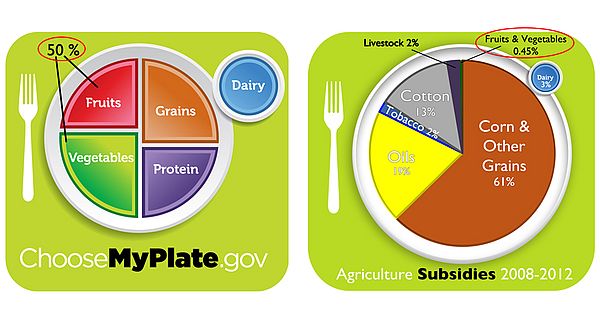Marion Nestle, Professor of Nutrition, Food Studies, and Public Health at New York University, decided to teach a course on the Farm Bill. The Farm Bill is the primary agricultural and food policy tool for the United States. It is passed every five years or so by the United States Congress and deals with both agriculture and all other affairs under the purview of the United States Department of Agriculture. She found the legislation, “too big, bloated and sprawling for any one human mind to absorb”.
The Farm Bill has long been recognized by left and right in the political spectrum as a mess. Both sides hate the subsidies sprinkled throughout the bill’s 357 pages: liberals because they support industrial agriculture, and conservatives because they distort market prices for food. Yet, every five years or so a new version of the Farm Bill is debated and passed.
Advocates for the Farm Bill have united two very different interest groups: farmers, and advocates for the poor. The Farm Bill includes not just subsidies for growers, but also programs for low-income, mostly urban populations. All told, the bill covers hundreds of programs each with their own “arcane stipulations and invested lobbyists” according to Nestle. The different pieces, if separated, would likely fail on their own. Once united, the political constituency is hard to beat.
As an indication of the inefficiencies enshrined in the Farm Bill, consider the discrepancy between what the bill funds, and what regulatory agencies describe as a healthy diet. The USDA recommends half of food consumed should be fruits and vegetables to promote a healthy diet, yet less than one percent of farm subsidies promotes these foods. Eighty percent of benefits go to corn, grains and soy oil which is one reason why so much agricultural land has been given over to these annual crops which have such a destructive impact on water quality.
The Farm Bill also includes many programs designed to protect the environment, but even these come under scrutiny. Erik Lichtenberg, University of Maryland Agricultural Economist, has looked at how conservation programs in the Farm Bill have changed through different iterations. These programs are how society addresses most environmental problems in agriculture, since agriculture is exempted from many environmental regulations. Lichtenberg notes that Farm Bill environmental programs create incentives to cut back on some activities that have negative environmental impacts, but that cost-sharing subsidies for conservation practices make farming more profitable, and thus create incentives for expanding operations.
“The only hope I see for meaningful change is grass-roots advocacy – a uniting of the many groups working on farm bill issues to create one loud voice for improving the bill, program by individual program,” concludes Nestle. As the bill has become more complex it becomes more difficult to critique individual elements. A broad-based national campaign is needed to drive reform, and it will take a tremendous effort to get it going.
